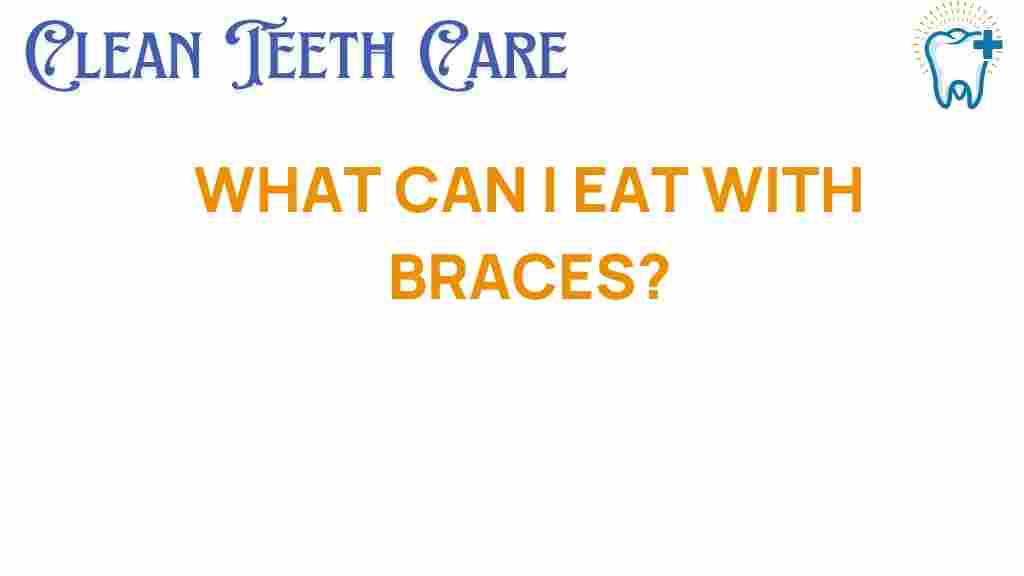Getting braces is an exciting step toward achieving a beautiful smile, but it also comes with some important dietary considerations. Understanding what foods are braces-friendly can make your orthodontic journey much smoother. In this article, we will explore the braces diet, discuss braces-friendly foods, and provide tips for maintaining excellent oral hygiene during your treatment. We’ll also cover essential aspects of dental care and orthodontics to ensure you enjoy a healthy eating plan while wearing braces.
Understanding Your Braces Diet
When you first get braces, you may feel overwhelmed by the sudden changes in your diet. The right braces diet can help you avoid discomfort and ensure your treatment progresses as planned. Foods that are hard, sticky, or chewy can damage braces, leading to delays and additional visits to your orthodontist. Here’s a breakdown of what you can eat and what you should avoid.
Braces-Friendly Foods
The key to a successful braces diet is to focus on foods that are soft or easy to chew. Here are some categories of braces-friendly foods:
- Soft Fruits: Bananas, applesauce, peaches, and berries.
- Cooked Vegetables: Mashed potatoes, steamed broccoli, and carrots.
- Dairy Products: Yogurt, cheese, and smoothies.
- Grains: Soft bread, pasta, and rice.
- Protein Sources: Eggs, tofu, and well-cooked chicken or fish.
In addition to these foods, consider incorporating healthy eating habits by choosing nutrient-dense options that support your overall well-being.
Foods to Avoid with Braces
While it’s essential to know what to eat, it’s equally important to understand the food restrictions that come with braces. Avoid the following:
- Hard Foods: Nuts, hard candies, and ice.
- Sticky Foods: Caramel, taffy, and chewing gum.
- Chewy Foods: Bagels, tough meats, and pizza crusts.
- Popcorn and Chips: These can easily get stuck in braces.
- Whole Fruits: Apples and carrots should be cut into smaller pieces.
By avoiding these foods, you can prevent damage to your braces and ensure that your orthodontic treatment stays on track.
Meal Planning While Wearing Braces
Meal planning is a crucial part of maintaining a braces diet. Here are some tips to help you plan your meals effectively:
- Batch Cooking: Prepare large portions of soft foods that can be stored in the fridge or freezer.
- Snack Wisely: Keep braces-friendly snacks on hand, such as yogurt and smoothies.
- Incorporate Variety: Experiment with different combinations of braces-friendly foods to avoid monotony.
- Stay Hydrated: Drink plenty of water to help maintain your oral hygiene.
By planning your meals in advance, you can make healthier choices and avoid the temptation of forbidden foods.
Maintaining Oral Hygiene with Braces
Good oral hygiene is vital while wearing braces. Food particles can easily get trapped in the brackets and wires, leading to plaque buildup and potential cavities. Here are some essential tips for dental care while you have braces:
- Brush Regularly: Brush your teeth after every meal using a soft-bristled toothbrush.
- Floss Daily: Use a floss threader or orthodontic floss to clean between your teeth and around the brackets.
- Use Mouthwash: Rinse with an antimicrobial mouthwash to help reduce plaque.
- Visit Your Orthodontist: Regular check-ups are important for monitoring your braces maintenance.
Maintaining excellent oral hygiene will not only keep your teeth healthy but also ensure that your braces work effectively.
Troubleshooting Common Issues with Braces
While wearing braces, you may encounter some common issues that can affect your diet and overall experience. Here are some troubleshooting tips:
- Discomfort: If you experience discomfort after adjustments, stick to softer foods for a few days.
- Loose Bracket: If a bracket becomes loose, inform your orthodontist as soon as possible to avoid further issues.
- Food Stuck in Braces: Use a toothbrush or a water flosser to gently remove any stuck food particles.
- Breaking a Wire: If you break a wire, cover the sharp end with wax until you can see your orthodontist.
By being proactive and addressing these issues quickly, you can minimize any disruptions to your braces diet.
Healthy Eating Beyond Braces
While it’s essential to follow a braces diet during your treatment, adopting healthy eating habits can benefit you long-term. Here are some tips for maintaining a balanced diet:
- Focus on Whole Foods: Incorporate fruits, vegetables, lean proteins, and whole grains into your daily diet.
- Limit Sugary Foods: Reducing sugar intake can help prevent cavities and support overall dental health.
- Stay Informed: Understanding nutrition can help you make better food choices.
- Seek Professional Advice: If you have specific dietary concerns, consider consulting a nutritionist.
Adopting these healthy eating habits will support your overall health and make your transition out of braces smoother.
Conclusion
Navigating your braces diet can seem challenging, but with the right knowledge and preparation, it can be a positive experience. By focusing on braces-friendly foods, maintaining good oral hygiene, and planning your meals effectively, you can enjoy a nutritious and satisfying diet while wearing braces. Remember to stay in touch with your orthodontist for regular check-ups and guidance throughout your treatment.
With patience and diligence, you will soon be rewarded with a beautiful smile that makes all the efforts worthwhile. For more resources on orthodontics and dental care, feel free to check out this comprehensive guide. And remember, your journey to a perfect smile starts with a healthy, braces-friendly diet!
This article is in the category Treatments and created by CleanTeethCare Team
